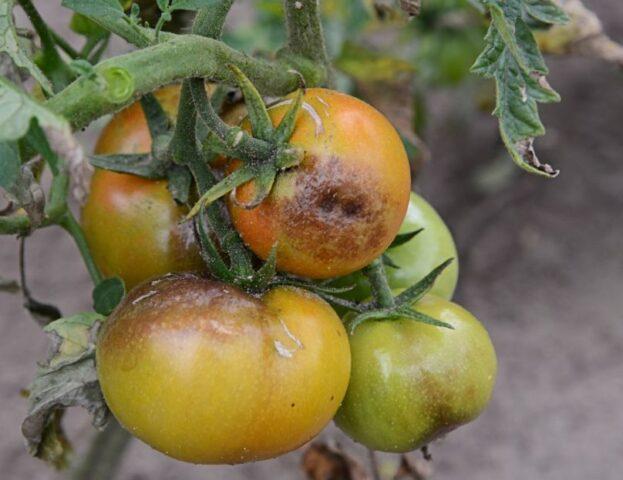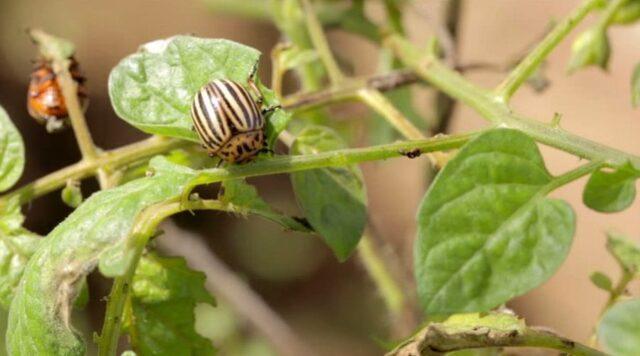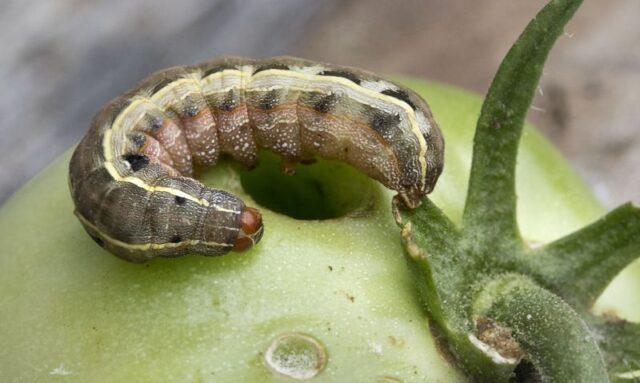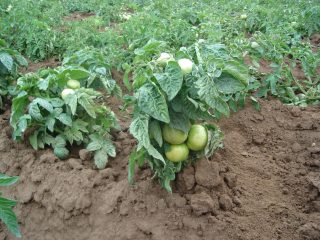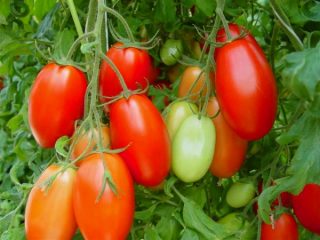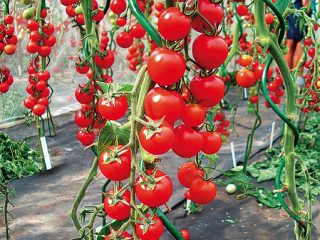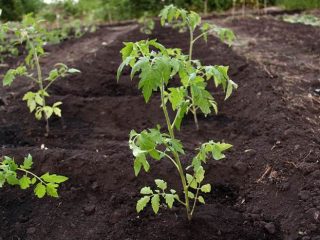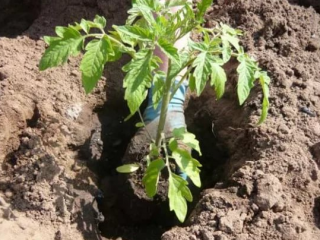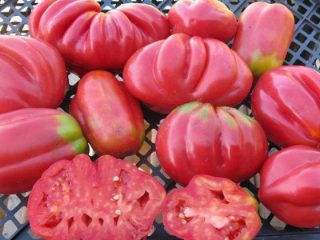Content
The Wild Thyme tomato is intended for cultivation in open ground and in greenhouse conditions. It is popular among gardeners due to its tasty and abundant fruits, but it has its drawbacks.
Description of the tomato variety Wild Thyme with photo
Wild Thyme is a determinate early tomato variety of American selection. Depending on growing conditions, it reaches 70-120 cm in height, develops in greenhouses and in open ground.
The leaves of the tomato are green, potato-type, wide and large, elongated-round in shape with a pointed end. The stems are dense and thick, supporting the weight of ripe fruit well. The first inflorescence appears above the 8-9 leaf of the plant. The ripening time for tomatoes outdoors is on average 110-120 days after the sprouts appear.
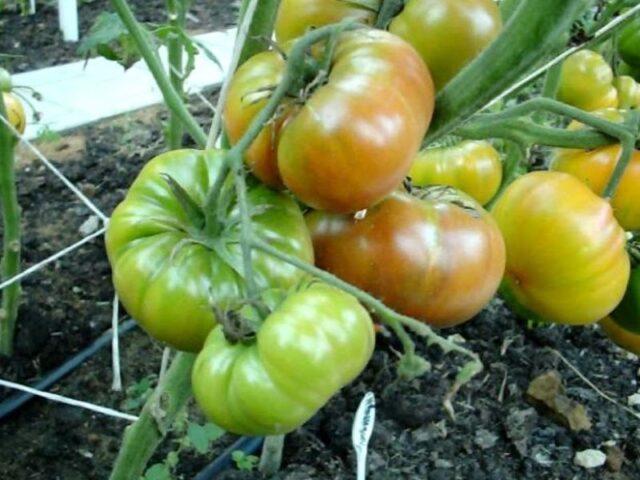
In greenhouse conditions, wild thyme usually grows up to 1 m
Characteristics of tomato Wild thyme
At the beginning of summer, the Wild Thyme tomato bears beautiful and juicy fruits weighing up to 150-200 g. Tomatoes have a flat-round shape, covered with an even and smooth dense skin.
A distinctive feature of the variety is the unusual coloring of the fruits. Upon reaching full ripeness, they acquire a light khaki shade with red-brown sides and a raspberry-pink “cap” at the top.
The flesh of tomatoes retains a dark emerald color, although in hot and sunny summers it may become reddish in the middle. The fruits inside are multi-chambered, with a large number of seeds.
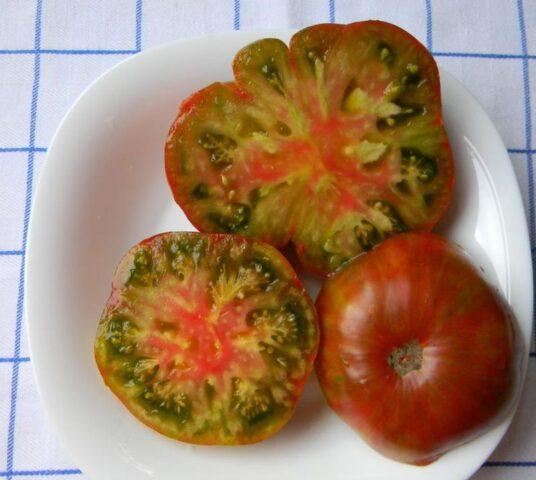
Wild thyme tomatoes have a pleasant sweetish taste and good juiciness
Tomato yield Wild thyme
The tomato variety has average yields and usually produces 5-8 kg of fruit per bush. Tomatoes are intended for fresh consumption and for adding to salads and main courses. This variety is rarely subjected to heat treatment and preservation.
Resistance to diseases and pests
Wild thyme has high immunity. With quality care and good soil, it rarely suffers from fungi and parasites. Despite this, the danger to the variety is posed by:
- late blight - the disease can be recognized by black or gray-brown spots on the leaves, browning of the stems and rot on the fruits; the fungus especially often affects plantings in humid and warm weather;
Tomatoes suffer from late blight usually from the second half of July
- the Colorado potato beetle, a pest with a bright striped shell, eats the leaves and shoots of tomatoes, multiplies quickly and is especially active in heat and drought;
The Colorado potato beetle easily adapts to insecticides, so it is difficult to remove.
- gnawing cutworm - an insect lays eggs on the leaves of tomato bushes; after a week, caterpillars appear, which feed on green parts and fruits over the next month.
The armyworm begins to harm tomatoes in mid-spring and produces several generations of caterpillars over the summer
Wild thyme pest control is carried out comprehensively. For the Colorado potato beetle, a manual collection method is used and they are sprayed with Colorado and Destroy preparations, as well as an infusion of onion peels. The Strela product helps well against the cutworm, destroying the larvae and caterpillars of the pest. Treatment of plantings is carried out according to instructions 3-4 times per season.
Copper sulfate solutions and the fungicidal drug Barrier help well against fungal diseases of tomato. But it is best to pay attention to high-quality prevention and prevent waterlogging and acidification of the soil.
Advantages and disadvantages of the variety
The Wild Thyme tomato is in demand among gardeners due to its good taste. But before planting a variety, it is necessary to comprehensively study its advantages and disadvantages.
Pros: · large and fleshy fruits; · sweet pleasant taste; · unusual colors of tomatoes; · early ripening; · equally well suited for vegetable gardens and greenhouses; · has a fairly high immunity to pests and fungi; · grows to an average height of 1.2 m and does not require complex gartering. | Minuses: · at the seedling stage demonstrates high sensitivity to drafts; · with uneven watering, the fruits crack; · poorly suitable for preservation and heat treatment; · suffers from late blight and the Colorado potato beetle; · average yield. |
Wild thyme is not a fussy species, but requires minimal attention from the gardener.
Features of cultivation
Caring for the Wild Thyme tomato is generally carried out according to standard rules. Tomato seedlings are planted in early spring and germinated in a lighted room for 60-65 days. After the final heat has been established, the seedlings are transferred to the beds and placed in prepared holes at intervals of 25-40 cm.
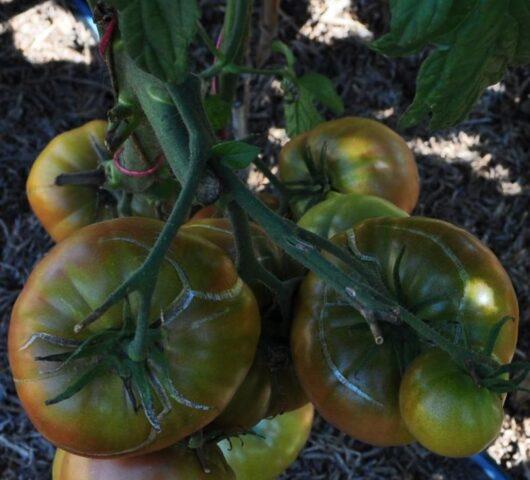
Tomato Wild thyme is recommended to be grown in beds after onions, carrots or legumes
In the process of growing a tomato variety, you need to pay attention to several points. The yield and size of the fruit largely depend on the quality of fertilizing and regularity of moisture.
Watering
Tomato Wild thyme does not respond well to waterlogged soil, but also does not like drought. It is necessary to moisten the plant twice a week or more often depending on the condition of the soil.
Water is added directly under the root, being careful not to irrigate the greenery of the bushes. Use the liquid, settled and lukewarm, and watering is carried out in the early morning or in the evening after sunset.
Top dressing
For abundant fruiting, tomato bushes require regular feeding. Throughout the season, wild thyme is fertilized several times:
- soon after planting in the ground - use an infusion of bird droppings or mullein with the addition of wood ash;
- ten days after the second flower cluster blooms, 15 g of complex mineral fertilizers with a predominance of potassium and phosphorus are added to 10 liters of organic solution;
- at the beginning of fruit ripening - they use the same phosphorus-potassium mixtures in combination with an infusion of organic matter, but apply only 500 ml of fertilizer for each bush;
- 14 days after the start of ripening - it is recommended to mix 20 g of superphosphate in 10 liters of Agricola-3 solution and water the plantings at the rate of 4 liters of fertilizer per 1 m2.
Stepsoning
As the Wild Thyme tomato develops, pinching is carried out for the bushes. The plant is grown in 2-3 stems, and the remaining shoots are cut off as they appear.
It is necessary to remove the stepsons when the latter reach a length of about 5 cm. They need to be broken off at a distance of about 1 cm from the main stem so as not to harm it. By the beginning of fruit ripening, there should be no extra shoots on the tomato bushes.
Garter
When the Wild Thyme tomato reaches a height of more than 1 m, it begins to bend down to the soil under the weight of the fruit. To prevent tomatoes from falling to the ground, install wooden or metal stakes next to the bushes and tie the stems with thick thread or soft twine.
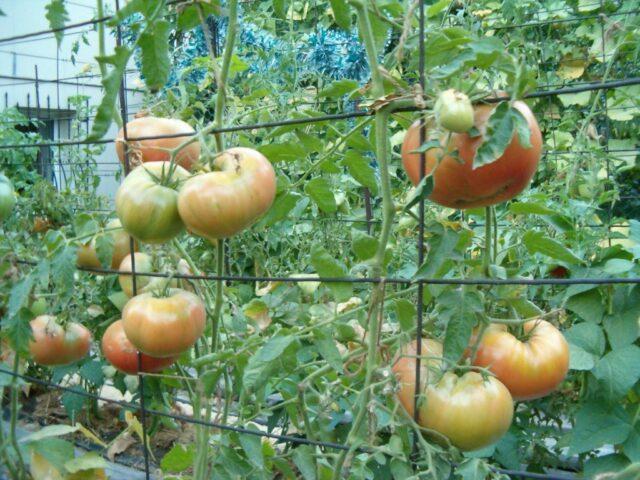
In a tomato greenhouse, you can install a trellis or mesh so as not to dig in a large number of supports
Loosening
Tomato Wild thyme develops well in breathable and light soil. To improve oxygen access to the roots of the bed, it is necessary to loosen it twice a month to a depth of 10 cm.
During the procedure, it is also recommended to remove weeds. They take away nutrients from the tomatoes and thicken the garden bed, in addition, they create conditions for the development of fungi.
Conclusion
The Wild Thyme tomato is popular due to its unusual color, pleasant taste and unpretentiousness. The rules for growing the variety are generally standard, but special attention should be paid to pinching and fertilizing.
Reviews of tomato Wild thyme
